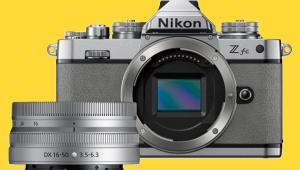Panasonic’s Lumix DMC-GF1; A 12MP Micro Four Thirds Camera
Micro Four Thirds format cameras promise of compact size, reduced weight, and versatility approaching a D-SLR. I recently had the opportunity to work with the Panasonic Lumix DMC-GF1 to see how it fulfilled those ambitions.
The GF1 is available only in kit form, with your choice of lens. One kit features the Lumix G 20mm f/1.7 ASPH “pancake” lens (so named for its flatness). Remember, since this camera uses the Four Thirds Live MOS sensor, that focal length is doubled. That still makes the 20mm (40mm equivalent) a very respectable street/candid lens, especially in low light and indoors, where flash may not be practical or allowed.
 |
|
|
|
GF1 Rear View
|
|
 |
|
|
|
GF1 Top View
|
|
 |
|
|
Boasting perhaps broader appeal, the other kit (the one tested) comes with the Lumix G Vario 14-45mm f/3.5-5.6 ASPH/MEGA O.I.S. The one drawback to the 20mm lens is that it doesn’t support Image Stabilization, whereas this zoom lens does. More to the point, on Panasonic G-series cameras, Optical Image Stabilization (O.I.S.) is solely a function of the lens—via an on-board switch (with input from the camera: you select the Stabilization mode). The Micro Four Thirds mount supports a variety of lenses, even lenses made specifically for other camera brands, adding to the appeal of this design.
You could probably take the GF1 out for a stroll without reading the voluminous manual (a hint at all the built-in functionality). Most of the function buttons are conveniently located on the right side, under your thumb, and easily identified. The one button that may be confusing is labeled “Q.Menu.” This button brings up the option to scroll through the most commonly used functions on the LCD display. In fact, all menu options are made via the large LCD on back, since there is no data panel on top. The only time I had any difficulty reading the screen, either for viewing/composing or menu selection, was under bright sunlight—and even then, it didn’t stop me from getting the shot. (You might want to avail yourself of the optional eye-level finder under these conditions—an item not tested.)
|
Mode-Sensitive Menu
|
|
 |
|
|
There are four cursor keys that surround the main Menu button.
Each cursor key is also dedicated to a specific function, namely ISO, AF mode, WB, and the user-defined Fn.
As with the Quick Menu, the main Menu options are sensitive to the operating/shooting mode. You get the widest range of options in the standard/creative modes, with fewer options in the camera-controlled/auto settings, such as Scene mode.
|
Facial Recognition
|
|
 |
|
|
Lots Of Shooting Modes
More experienced shooters will likely use MAPS (Manual, Aperture-priority, Program, Shutter-priority) modes, which take you on the road to more creative picture making. When you select the My Color mode, you are automatically locked out of using ISO selection and exposure compensation. Even the Quick Menu has been grossly truncated for this mode. Your taste will dictate how often you use these effects. Scene mode gives you numerous predefined choices that run the gamut from portrait to sports, landscape, night scenery, sunset, and many more. Hit Display and an explanation pops up.
|
14-45mm/Landscape: Capturing Reflections
|
|
 |
|
|
The one mode that I did find myself using, despite a natural inclination to avoid it, was iA (intelligent Auto)—marked in red on the dial to distinguish it. Here the camera appears to shine with a wisdom all its own. You still have control over exposure compensation and flash, but are otherwise largely locked out of the decision-making process.

















































